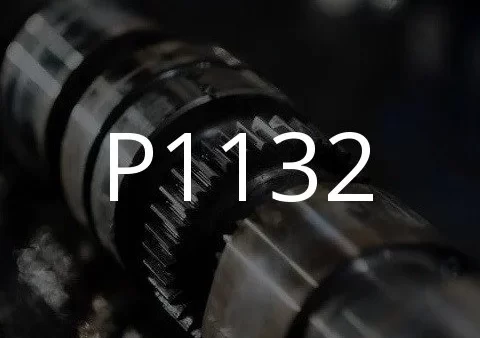
P1132 (Volkswagen, Audi, Skoda, Seat) Electrical circuit for heating oxygen sensor (HO2S) 1, block 1+2 - short circuit to positive
Content
P1132 – OBD-II Trouble Code Technical Description
Trouble code P1132 indicates a short circuit to positive in the heated oxygen sensor (HO2S) 1 circuit, block 1+2 in Volkswagen, Audi, Skoda, Seat vehicles.
What does the fault code mean P1132?
Trouble code P1132 indicates a short circuit in the heated oxygen sensor (HO2S) circuit, bank 1+2, sensor 1. The oxygen sensor plays a key role in monitoring and regulating the air/fuel mixture, which in turn affects combustion efficiency and emissions. harmful substances in exhaust gases. A short circuit in the sensor circuit can cause the emission control system to malfunction, which can cause engine roughness, increased emissions, and reduced vehicle performance.

Possible reasons
Several possible reasons for the P1132 trouble code:
- Damage to wiring or connectors: A short circuit in the oxygen sensor circuit may be caused by damaged wiring or connectors, resulting in incorrect signal transmission.
- Oxygen sensor malfunction: The oxygen sensor (HO2S) itself may be damaged or failed, resulting in incorrect signals being sent to the engine control module.
- Engine controller problems: Malfunctions or malfunctions in the engine control module can also cause this error code to appear.
- Low supply voltage: Insufficient voltage on the oxygen sensor circuit can also cause this code to appear.
- Problems with the exhaust system: Restricted exhaust system flow, such as a clogged catalytic converter or ECU (electronic control unit) malfunction, can cause the oxygen sensor to malfunction and cause code P1132 to appear.
What are the symptoms of a fault code? P1132?
Some of the possible symptoms of trouble code P1132:
- Loss of power: A malfunctioning oxygen sensor may result in loss of engine power due to improper control of the fuel injection system.
- Unstable idle: If the oxygen sensor is faulty, the engine may idle rough and run rough.
- Increased fuel consumption: Improper air/fuel mixing may result in increased fuel consumption due to poor combustion efficiency.
- Black smoke from the exhaust pipe: When excess fuel is mixed with air, incomplete combustion may occur, resulting in black smoke in the exhaust.
- Unstable engine performance: The engine may experience rough operation at idle or at low speeds, especially when the engine is under load.
- The appearance of errors in the engine management system: Error codes or Check Engine lights may appear on the dashboard if the oxygen sensor is faulty and the P1132 code is activated.
How to diagnose a fault code P1132?
To diagnose DTC P1132, you can follow these steps:
- Checking wiring and connections: Check the wiring and connectors connecting the oxygen sensor to the central engine control module (ECM). Make sure all connections are secure, there is no damage to the wiring and there is no corrosion on the contacts.
- Resistance test: Using a multimeter, check the resistance in the oxygen sensor circuit. Normal resistance may vary depending on the specific vehicle model. The resistance must be within the permissible values specified in the repair manual or technical documentation.
- Checking supply voltage and grounding: Using a multimeter, check the power and ground voltage at the oxygen sensor. The supply voltage must be within normal limits and the grounding must be good.
- Replacing the oxygen sensor: If all electrical connections are checked and working properly and the P1132 code continues to appear, the oxygen sensor may need to be replaced. You should ensure that the new sensor meets the manufacturer's specifications and is installed correctly.
- Additional diagnostics: If the problem persists after replacing the sensor, a more in-depth diagnosis of the vehicle's electrical system may be required, including checking the engine central control module (ECM) for faults or updating the software.
Remember that it is better to contact a qualified technician or auto mechanic to diagnose and repair your vehicle.
Diagnostic errors
When diagnosing DTC P1132, the following errors may occur:
- Misinterpretation of symptoms: Sometimes symptoms such as loss of power or rough idling can be attributed to problems other than a faulty oxygen sensor.
- Incorrect component replacement: Diagnosing fault codes often results in replacing components without adequately analyzing the cause of the problem. This can lead to unnecessary costs for replacing parts if the cause of the problem is found to be elsewhere.
- Ignoring other problems: When a P1132 code is detected, other potential problems that may be affecting engine performance, such as problems with the fuel system or ignition system, may be ignored.
- Insufficient circuit diagnostics: The cause of a short circuit or open circuit in the oxygen sensor circuit may be associated not only with the sensor itself, but also with problems in the electrical circuit, for example, broken wiring or corrosion of the contacts. Insufficient diagnostics of the electrical circuit can lead to incorrect identification of the cause of the malfunction.
How serious is the fault code? P1132?
Trouble code P1132, which indicates a short circuit in the heated oxygen sensor (HO2S) 1 bank 1+2 circuit, can affect engine and emission control system performance. Although this is not a critical malfunction, it can lead to improper engine operation, poor environmental performance and increased fuel consumption.
Failure to professionally resolve the problem or ignore this code may result in further deterioration of engine performance and increased fuel costs. Therefore, it is recommended to diagnose and eliminate the cause of this malfunction as soon as possible.
What repair will help eliminate the code? P1132?
To resolve DTC P1132 indicating a short circuit in the heated oxygen sensor (HO2S) 1 bank 1+2 circuit, perform the following steps:
- Heated Oxygen Sensor (HO2S) Test: Test the heated oxygen sensor to determine if it is faulty. If the sensor is faulty, replace it with a new one.
- Electrical Circuit Check: Check the electrical circuit connecting the oxygen sensor to the engine control module (ECU). Make sure there are no broken wires, no corrosion, and connections are secure.
- Checking the Engine Control Module (ECU): In some cases, the problem may be related to the Engine Control Module. Diagnose the ECU and replace it if necessary.
- Clearing the DTC: After completing repairs, clear the DTC using a diagnostic tool or disconnect the negative battery terminal for a few minutes.
- Retest: After repairs have been made and the DTC has cleared, retest the system to ensure the problem has been resolved.
It is important to follow the repair and service manual for your specific vehicle model when performing these steps. If you are unsure of your skills or experience, it is recommended that you contact a qualified auto mechanic.

